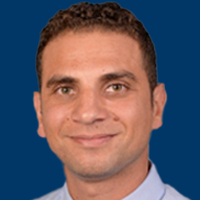Expanding Immunotherapy Armamentarium Propels Personalized HCC Treatment Approaches
Richard Kim, MD, discusses the range of systemic treatment options available for patients with unresectable hepatocellular carcinoma and the importance of assessing patients for high-risk disease criteria before beginning any systemic treatment.
Richard Kim, MD

Patient characteristics factor heavily into hepatocellular carcinoma (HCC) treatment decisions, according to Richard Kim, MD, who emphasized that the risks and benefits of standard surgical procedures and systemic therapy regimens, such as durvalumab (Imfinzi) plus tremelimumab-actl (Imjudo) and atezolizumab (Tecentriq) plus bevacizumab (Avastin), must be considered for all patients, particularly those with high-risk disease.
The phase 3 HIMALAYA trial (NCT03298451) investigated tremelimumab plus durvalumab vs durvalumab monotherapy vs sorafenib (Nexavar) monotherapy in patients with unresectable HCC who had not received prior systemic therapy. In this trial, tremelimumab plus durvalumab elicited a median overall survival (OS) of 16.43 months (95% CI, 14.16-19.58) vs 16.56 months (95% CI, 14.06-19.12) with durvalumab monotherapy and 13.77 months (95% CI, 12.25-16.13) with sorafenib.1
The phase 3 IMbrave150 trial (NCT03434379) evaluated the combination of atezolizumab and bevacizumab in patients with treatment-naïve unresectable HCC. The 12-month OS rate was 67.2% (95% CI, 61.3%-73.1%) with the investigational combination vs 54.6% (95% CI, 45.2%-64.0%) with sorafenib.2
“In each case, one needs to decide [on a therapeutic regimen] depending on each patient’s situation,” Kim said in an interview with OncLive® following a State of the Science Summit™ (SOSS) on gastrointestinal cancers, which he chaired.
In the interview, Kim discussed the HCC case study he presented at the SOSS, the range of systemic treatment options available for patients with unresectable HCC, and the importance of assessing patients for high-risk disease criteria before beginning any systemic treatment.
Kim is a service chief of Medical Gastrointestinal Oncology and a senior member in the Gastrointestinal Oncology Department at Moffitt Cancer Center, as well as a professor of oncology at the University of South Florida College of Medicine, both in Tampa, Florida.
OncLive: Please describe the case study you presented.
Kim: The case I presented was a 62-year-old man who has a history of hyperlipidemia and untreated hepatitis C. He also has a history of ethanol abuse and IV drug abuse but quit many years ago. He presented to the emergency room [ER] complaining of severe abdominal pain and it was 10 out of 10 on the pain scale, with nausea and vomiting.
In the ER, they did a computed tomography scan of the abdomen and pelvis that showed a ruptured mass in the liver. At the time, they did some workup for laboratories, and they found that his hemoglobin levels were low, but [he had] normal platelet counts. His alpha fetoprotein levels were elevated, at 375 ng/mL. [The other laboratory results showed that the patient had] bilirubin levels of 1.0 mg/dL and albumin levels of 1.2 g/dL, so the patient had Child-Pugh A liver cirrhosis.
Once the imaging was reviewed, because the tumor was bleeding, they needed to stop the bleeding as soon as possible. The patient underwent a blood embolization to stop the bleeding. At the time, they also did a biopsy that was consistent with HCC.
Then the patient presented in our clinic, and the decision was made to present [his case] at the tumor board to determine next steps. Our surgeons looked at the scans, and they felt that the tumor could be resectable, however, there were some concerns. The major concern was that the patient had a ruptured tumor, which makes it high risk. They were also concerned about the liver remnants—they need to have enough liver remnants behind for them to do surgery and when the patient first presented, they didn’t feel he had enough of the left side of the liver left for them to do any surgical procedure.
This case happened a couple years ago before all the immunotherapies came about. However, if this case had occurred in 2023, because of the patient’s high-risk disease, with high levels of alpha fetoprotein, evidence of ruptured tumor, and the fact that the tumor on the right side [of the liver] did not leave enough liver remnants [on the left side] to do surgery, the decision would be to give some form of systemic therapy. Because the patient had ruptured bleeding, an anti-VEGF inhibitor may be difficult in the setting. Therefore, the obvious choice would be potentially using the combination of durvalumab and tremelimumab, based on the HIMALAYA data, which showed a durable response with an improvement in OS [in patients with unresectable HCC who received this combination vs those who received durvalumab monotherapy or sorafenib].
The plan [would be] to give 3 months of durvalumab and tremelimumab and then reassess to see how the tumor was responding or not responding. In this case a couple years ago, the tumor did not progress, and 3 or 4 months later, the patient underwent portal vein embolization to enlarge the left side of liver. Eventually, the patient underwent surgery, and our surgeon was able to take out the whole right side of the tumor.
What other systemic therapy options may benefit patients with disease characteristics similar to the one in the case study?
In a patient with resectable HCC, we typically do not give neoadjuvant therapy, because of a lack of data [to support that decision]. However, in this case, because of the high-risk [nature of the disease, including the] high levels of alpha fetoprotein and the fact that the tumor ruptured, we could give neoadjuvant therapy to ensure no progression of disease.
We could argue [about the] kinds of regimens that are available for this patient. In 2023, luckily, we have many options. We have a combination with atezolizumab plus bevacizumab that is a combination of immunotherapy and VEGF [inhibition]. There are combination immunotherapy/immunotherapy [regimens], such as durvalumab and tremelimumab. There are TKIs as well [that may help] maintain the disease. We have some choices available but depending on each scenario, you could choose 1 regimen over the others. However, in the [cases such as the one I presented], where bleeding was a risk factor, I would not use a VEGF inhibitor.
Tiago Biachi, MD, PhD, of Moffitt Cancer Center, also spoke about updates in HCC management. What factors inform your choice to use the HIMALAYA regimen or the IMbrave150 regimen in the frontline setting?
Dr Biachi discussed the standard guidelines in the management of advanced HCC. Currently, there are, luckily, many FDA-approved drugs. The main component we use in the first-line setting is immunotherapy based.
Two large, phase 3 studies were positive in the first-line setting. The IMbrave150 trial [investigated] the combination of atezolizumab plus bevacizumab [and reported data in 2020]. Additionally, the HIMALAYA trial used durvalumab plus tremelimumab and showed an OS benefit [with the immunotherapy combination vs single-agent durvalumab or sorafenib].
There was a discussion at our meeting to see which regimen you should use. Cross-trial comparisons should not be done, but we do them anyway. There’s a catch to this [comparison] because the inclusion criteria were different between these 2 trials. For example, the IMbrave150 study enrolled more patients with hepatitis and underlying liver cirrhosis, vs in the HIMALAYA study population, there were more patients with nonalcoholic steatohepatitis or nonviral liver cirrhosis.
The etiology matters. More data are coming out [to support that] maybe [in patients with] viral etiology, immunotherapy may work better than [in those with] nonviral etiology, but they are too premature to say that’s the standard of care. For example, in the IMbrave150 study, clearly, the patients with viral etiology did much better with atezolizumab plus bevacizumab. On the other hand, in the HIMALAYA data, [both the patients with] viral and nonviral disease benefited from durvalumab plus tremelimumab.
There are still mixed data out there, so [these data] are not ready for primetime for us to use the viral or nonviral etiology to choose the first-line treatment. However, both regimens have pros and cons that one needs to [consider] before choosing one regimen. There are advantages of using atezolizumab plus bevacizumab regarding maybe delivering higher response rates. However, there is always the concern that you need to do an endoscopy before starting this regimen because of the potential risk of bleeding. That may take some time away. The issues with durvalumab and tremelimumab are that because you’re giving 2 immunotherapies, there may be higher rates of immune-mediated adverse effects, which would sometimes require steroids. There are pros and cons in each setting.
What ongoing or planned research at Moffitt Cancer Center may advance the HCC treatment paradigm?
Regarding HCC, there are a lot of TKIs and immunotherapies available. Currently at Moffitt Cancer Center, we have a novel drug targeting the STAT3 pathway. We have a [phase 1b/2 trial (NCT05440708)] with a STAT3 inhibitor as a single agent in a refractory setting, in combination with atezolizumab plus bevacizumab in the first-line setting, or in the second-line setting in combination with pembrolizumab [Keytruda] in patients who [progressed on] immunotherapy. This is another drug class we’re working on to improve upon what we have so far.
Another trial that’s not open yet [is investigating] a CAR T-cell therapy targeting the GCC antigen in HCC. GCC is only expressed in tumor cells and spares the normal hepatocytes, potentially sparing some toxicity. Hopefully that trial will open at Moffitt Cancer Center in the future.
References
- Abou-Alfa GK, Lau G, Kudo M, et al. Tremelimumab plus durvalumab in unresectable hepatocellular carcinoma. NEJM Evid. 2022;1(8). doi:10.1056/EVIDoa2100070
- Finn RS, Qin S, Ikeda M, et al. Atezolizumab plus bevacizumab in unresectable hepatocellular carcinoma. New Engl J Med. 2020;382(20):1894-1905. doi:10.1056/NEJMoa1915745



